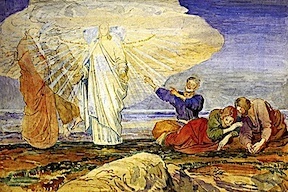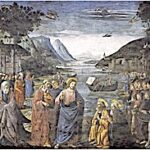Illustration: Transfiguration by Alexandr Ivanov, 1824
Homily of Pope Francis for Lent 2023
‘Lenten Penance and the Synodal Journey’
“We must listen to Jesus” & “We must follow Jesus – him alone!”
Gospel Reading on the Transfiguration (Matthew 17:1-9)
Jesus took with him Peter and James and his brother John and led them up a high mountain where they could be alone. There in their presence he was transfigured: his face shone like the sun and his clothes became as white as the light. Suddenly Moses and Elijah appeared to them; they were talking with him. Then Peter spoke to Jesus. ‘Lord,’ he said ‘it is wonderful for us to be here; if you wish, I will make three tents here, one for you, one for Moses and one for Elijah.’ He was still speaking when suddenly a bright cloud covered them with shadow, and from the cloud there came a voice which said, ‘This is my Son, the Beloved; he enjoys my favour. Listen to him.’ When they heard this the disciples fell on their faces overcome with fear. But Jesus came up and touched them. ‘Stand up,’ he said ‘do not be afraid.’ And when they raised their eyes they saw no one but only Jesus. As they came down from the mountain Jesus gave them this order, ‘Tell no one about the vision until the Son of Man has risen from the dead.’
Dear Brothers and Sisters!
The Gospels of Matthew, Mark and Luke all relate the episode of the Transfiguration of Jesus. There we see the Lord’s response to the failure of his disciples to understand him. Shortly before, there had been a real clash between the Master and Simon Peter, who, after professing his faith in Jesus as the Christ, the Son of God, had rejected his prediction of the passion and the cross.
Jesus had sharply rebuked him: “Get behind me, Satan! You are a scandal to me, because you do not think according to God, but according to men.” (Mt 16:23).
Then, “six days later, Jesus took with him Peter, James and John his brother and led them up to a high mountain” (Mt 17:1).
The Gospel of the Transfiguration is proclaimed every year on the Second Sunday of Lent. During this liturgical season, the Lord takes us with him to a place apart.
While our ordinary commitments force us to remain in our usual places and our often repetitive and sometimes boring routines, during Lent we are invited to ascend “a high mountain” with Jesus and to live a special experience of spiritual discipline – asceticism – as God’s holy people.
Lenten penance is a commitment, sustained by grace, to overcome our lack of faith and our resistance to following Jesus on the way of the cross. This is exactly what Peter and the other disciples needed to do. To deepen our knowledge of the Master, to fully understand and embrace the mystery of his salvation, accomplished in total self-giving inspired by love, we must allow ourselves to be taken aside by him and to be freed from mediocrity and vanity.
We must set out on the journey, an uphill path that, like a mountain trek, requires effort, sacrifice and concentration. These requirements are also important for the synodal journey to which, as a Church. We can benefit greatly from reflecting on the relationship between Lenten penance and the synodal experience.
In his “retreat” on Mount Tabor, Jesus takes three disciples with him, chosen to be witnesses to a unique event. He wants this experience of grace to be shared, not solitary, just as our whole life of faith is a shared experience. For it is in community that we follow Jesus.
We also experience the liturgical year and Lent together as a Church pilgrim in time, walking alongside those whom the Lord has placed among us as fellow travelers.
Like the ascent of Jesus and the disciples to Mount Tabor, we can say that our Lenten journey is “synodal”, because we walk together on the same path, as disciples of the one Master.
For we know that Jesus himself is the Way, and therefore, both in the liturgical journey and in the journey of the Synod, the Church does nothing other than enter ever more deeply and fully into the mystery of Christ the Savior.
And so we come to its culmination. The Gospel tells us that Jesus “was transfigured before them; his face shone like the sun and his clothes were white as light” (Mt 17:2).
This is the “summit”, the goal of the journey.
At the end of their ascent, standing with Jesus on the mountaintop, the three disciples have the grace of seeing him in his glory, radiant in a supernatural light.
This light did not come from outside, but emanated from the Lord himself.
The divine beauty of this vision was incomparably greater than any effort the disciples had made in climbing Mt. Tabor. In any arduous climb, we must keep our eyes fixed on the path, but the panorama that opens up at the end amazes us and rewards us with its grandeur. n the same way, the synodal process may often seem arduous, and at times we may become discouraged. But what awaits us at the end is undoubtedly something wonderful and amazing, which will help us to understand better God’s will and our mission in the service of his Kingdom..
The disciples’ experience on Mount Tabor was further enriched by the appearance of Moses and Elijah, representing the Law and the Prophets, respectively, alongside the transfigured Jesus (cf. Mt 17:3). The newness of Christ is at the same time the fulfillment of the old covenant and promises; it is inseparable from the history of God with his people and reveals its deeper meaning. In a similar way, the synodal journey is rooted in the Church’s tradition and at the same time open to newness. Tradition is a source of inspiration for seeking new ways and for avoiding the opposite temptations of immobility and improvised experimentation.
Both he Lenten journey of penance and the journey of the Synod alike have as their goal a personal and ecclesial transfiguration. A transformation which, in both cases, has its model in the Transfiguration of Jesus and is accomplished by the grace of His paschal mystery. In order that this transfiguration may become a reality in us this year, I would like to propose two “ways” to follow in order to climb the mountain with Jesus and to attain the goal with Him,.
1st Proposal: We must listen to Jesus
The first proposal has to do with the command that God the Father addresses to the disciples on Mount Tabor as they contemplate the transfigured Jesus.
The voice from the cloud says: “Listen to him” (Mt 17:5).
The first proposal, then, is very clear: we need to listen to Jesus.
Lent is a time of grace to the extent that we listen to Him when he speaks to us.
And how does he speak to us?
First of all, through the word of God that the Church offers us in the liturgy.
Let this word not fall on deaf ears; if we cannot always attend Mass, let us study its daily Scripture readings, even with the help of the Internet.
In addition to Sacred Scriptures, the Lord speaks to us through our brothers and sisters, especially in the faces and the stories of those who are in need.
I would like to say something else, that is very important for the synodal process: listening to Christ often takes place in listening to our brothers and sisters in the Church.
Such mutual listening is in some phases the primary goal, but it always remains indispensable in the method and style of a synodal Church.
When the disciples heard the voice of the Father, “fell down and were very afraid. Bur Jesus came and touched them and said, ‘Rise, and do not be afraid.’ And when the disciples raised their eyes, they saw no one else but Jesus alone” (Mt 17:6-8).
2nd Proposal: We must Follow Jesus – him alone
Here is the second proposal for this Lent: do not take refuge in a religiosity made up of extraordinary events and dramatic experiences, for fear of facing reality and its daily struggles, its hardships and contradictions.
The light that Jesus shows to His disciples is an anticipation of the glory of Easter, and this must be the goal of our own journey, as we follow “him alone”.
Lent leads to Easter: the “retreat” is not an end in itself, but a means to prepare us to live the Passion and the Cross of the Lord with faith, hope and love, and thus to arrive at the Resurrection.
Even on the synodal journey, when God gives us the grace of certain powerful experiences of communion, we must not imagine that we have arrived – because there too, the Lord repeats to us: “Arise, and do not be afraid”.
So let us go down, then, to the plain, and may the grace we have experienced strengthen us to be “artisans of synodality” in the ordinary life of our communities.
Dear brothers and sisters, may the Holy Spirit inspire and sustain us this Lent in our ascent with Jesus, so that we may experience his divine splendor and thus, confirmed in faith, persevere in our journey together with him, the glory of his people and the light of the nations.
Rome, Saint John Lateran, 25 January, Feast of the Conversion of Saint Paul
FRANCIS


